Scattered across the windswept landscapes of the highlands to the cobbled streets of ancient cities, the landmarks of Scotland represent the country’s rich and proud history. Scotland’s landscape is subject to extremes in weather due to its location, with some islands stretching closer to Norway than the Scottish shores. This diversity in climate provides a land prized for its beauty, culture and history.
This incredible landscape has given the world remarkable talents such as Sir Walter Scott, Robert Burns, Alexander Graham Bell and Muriel Spark. Retaining a separate identity to England for centuries, Scotland prides itself on being a separate country deeply engrained in its history and legends, which make for a spectacular place to visit. Here are 20 landmarks in Scotland that you cannot miss.
Contents
20 Famous Landmarks in Scotland
Historic Landmarks in Scotland
1- Stirling Castle
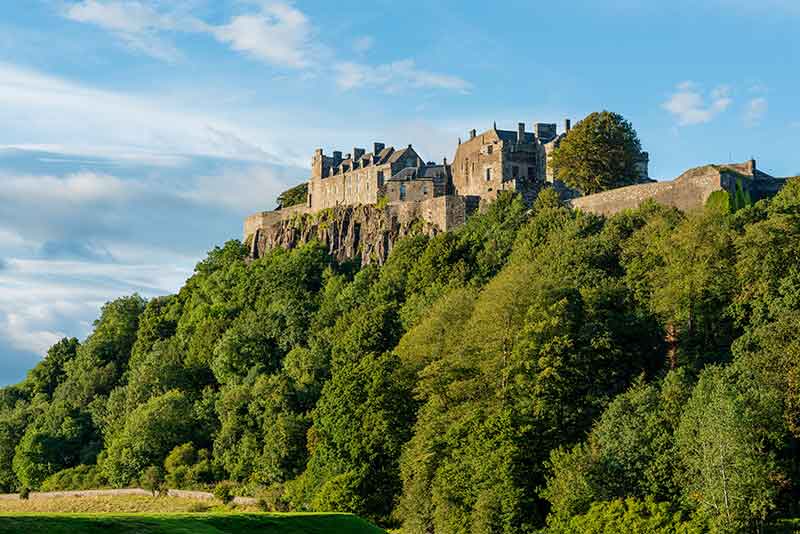
One of Scotland’s most important historical sites is Stirling Castle, which was built between 1496 and 1583.
The castle has a long and bloody history and was the residence of Stewart Kings and Queens.
Stirling Castle sits high on top of a volcanic rock as has sweeping views across the countryside.
The grounds of the castle feature sculptures and statues, stunning gardens and quiet nooks.
The castle itself was besieged at least 16 times whilst occupied by the Stewarts, leaving many dead and lots of damage to the castle that has since been repaired.
It has a murderous past, with a King murdered close by, and another murder committed by a King within the castle walls.
2- Glenfinnan Viaduct
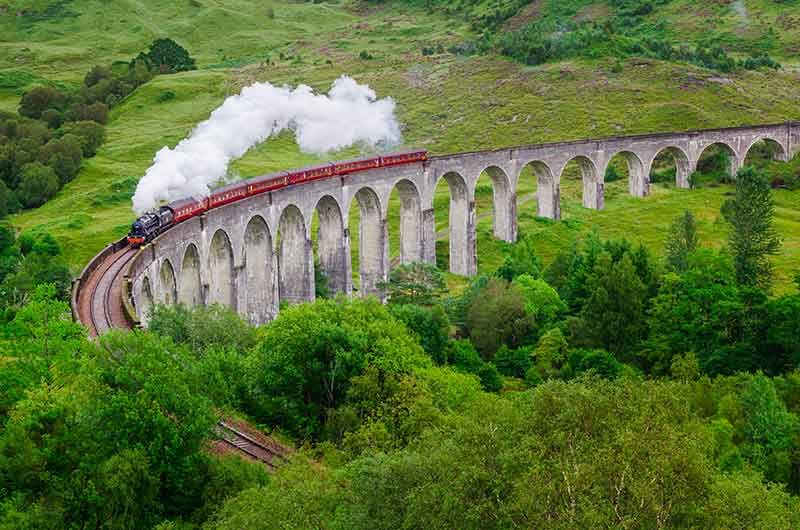
Engineered in 1901 by Simpson and Wilson, the Glenfinnan Viaduct is a beautiful arched viaduct railway bridge that stretches across the highlands.
Perhaps most famous for its role in the Harry Potter series, the viaduct allows the Jacobite steam train to move between small Scottish towns on the way to Mallaig.
This journey is regarded by many as one of the most spectacular in the world and travelling on the Jacobite is recommended for the scenery surrounding the viaduct.
However, there are many accessible locations close to the viaduct for photographers to capture this incredible feat of engineering, and perhaps even get a shot of the steam train as it passes over.
3- Skara Brae
Built in around 3180BC and occupied until 2500BC, Skara Brae is a Neolithic settlement built from stone.
The settlement at Skara Brae’s location was a mystery until severe storms hit in 1850.
The storms were so wild that grass was ripped out of the ground from a dune known as Skara Brae, which sits beside the Bay of Skaill.
Following the storm, this ancient settlement was revealed.
As it was covered with earth for centuries, the buildings are well preserved, and archaeologists have named Skara Brae as the best-preserved Neolithic village in Northern Europe.
Within Skara Brae, visitors can view stone beds, tables and seats, as well as visiting a replica house to show what life was like for the people who lived there.
4- Calanais Standing Stones
The Calanais Standing Stones on the Isle of Lewis were erected more than 5000 years ago, predating the stones at England’s Stonehenge.
The stones are believed to have been a place of ritual activities for around 2000 years.
Similarly to Stonehenge, there is no clear reason for the stones to have been positioned in such a manner, however, it is theorised that the stones are were part of an ancient astrological observatory.
5- Maeshowe Chambered Cairn
Another one of Scotlands ancient sites is Maeshowe Chambered Cairn in Orkney, which is approximately 5000 years ago and a Cairn with a fascinating history.
The entrance to the Cairn is aligned to meet the setting of the sun in midwinter, allowing for a natural way to illuminate the chamber inside.
There is evidence within the Cairn of invasion from Norse crusaders during the 1100s, as runes have been carved into the walls of the main chamber, believed to be an example of early graffiti by archeologists.
6- Falkland Palace and Garden
Falkland Palace and Garden was the country residence of the Stewarts and was frequented by Mary Queen of Scotts.
An extraordinary example of Renaissance architecture, the palace took its inspiration from the grand chateaux of France in the 16th Century.
Both James IV and his son, James V made detailed additions and transformations to the palace to turn it into one of the finest buildings in Scotland.
Within the gardens is one of Britain’s oldest original, real grass tennis courts.
7- Dornach Cathedral
It is unclear as to when building work began on Dornoch Cathedral, however it was along far enough for the first service to be held within its walls in 1239.
The cathedral was set on fire in 1570, with many tombs desecrated during a clan feud between the Murrays of Dornoch and the Mackays of Strathnaver.
Due to the destruction, the cathedral underwent a partial restoration in 1616, with work completed in the mid-1800s.
The exterior of the cathedral features grotesque gargoyles set into the eaves, which were at one time thought to be evil spirits that had been transformed to stone upon hearing the ringing of the bells of the cathedral.
8- Jarlshof Prehistoric and Norse Settlement
In Shetland lies Jarlshof Prehistoric and Norse Settlement, which was actively lived in for 4000 years, settled around 2700BC and in use until the 1600s.
Archaeologists working on the site have uncovered oval-shaped Bronze Age houses, Iron Age broaches and Norse longhouses.
The settlement’s location not only provided security for its inhabitants but dramatic views over West Voe of Sumburgh.
9- Bannockburn
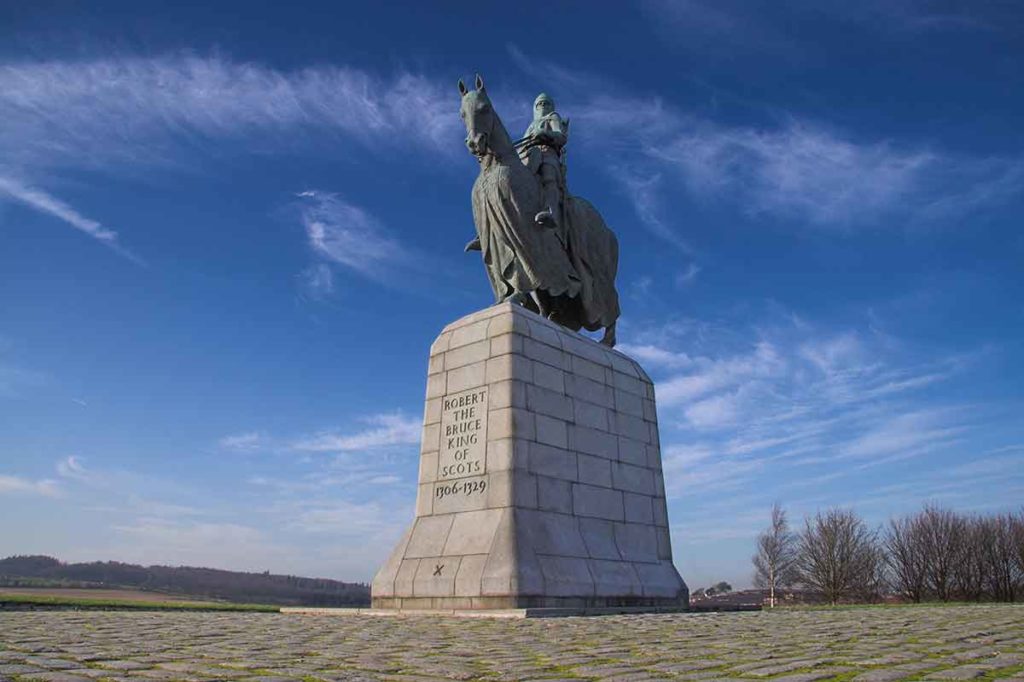
One of the most famous battles in Scotland’s history, the site where the Battle of Bannockburn was fought, is one of the most important historical landmarks in Scotland.
What was once the scene of a bloody and violent battle, Bannockburn is now a beautifully landscaped area of parkland.
Within the memorial park is a statue of Robert the Bruce, and the spot where he raised his royal standard has been marked.
An interactive exhibition is accessible in which the full details of the battle, its build-up and fallout, are revealed.
For more amazing European Landmarks, read:
- 30 Spain Landmarks
- 20 Switzerland Landmarks
- 22 Germany Landmarks
- 35 London Landmarks
- 30 France Landmarks
- 20 Italy Landmarks
- 20 Greece Landmarks
- 20 Russia Landmarks
- 20 Scotland Landmarks
- 20 Ireland Landmarks
- 21 Wales Landmarks
- 20 Turkey Landmarks
- 20 England Landmarks
- 20 Hungary Landmarks
- 21 Romania Landmarks
- 20 Ukraine Landmarks
- 20 Athens Landmarks
- 20 Rome Landmarks
- 20 England Landmarks
- 20 Portugal Landmarks
- 20 Poland Landmarks
- 20 Iceland Landmarks
- 20 Bulgaria Landmarks
- 21 Croatia Landmarks
- 20 Bulgaria Landmarks
- 20 Austria Landmarks
- 21 Finland Landmarks
- 20 Sweden Landmarks
- 20 Denmark Landmarks
- 20 Belgium Landmarks
- 20 Netherlands Landmarks
- 20 Barcelona Landmarks
- 21 Czech Republic Landmarks
- 20 Landmarks in Paris
- 20 Landmarks in Liverpool
- 10 Istanbul Landmarks
Natural Landmarks in Scotland
10- Loch Ness
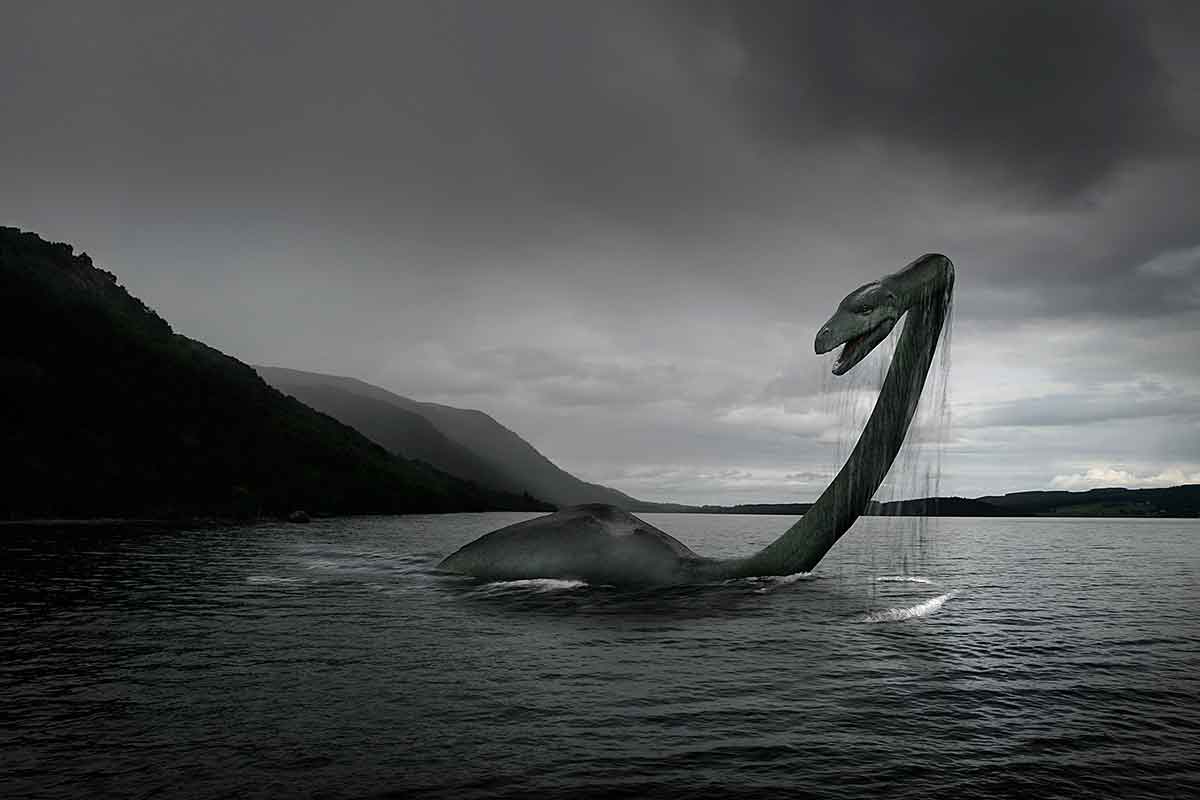
Perhaps the most famous of Scotland’s natural landmarks is Loch Ness.
The loch, located near Inverness, is filled with legends of the famous Loch Ness Monster, or Nessie as she is fondly called.
Said to live deep underneath the surface of the loch, there have been over 1000 reported sightings of Nessie, with the first photograph captured in 1933.
This has, of course, lead to Loch Ness becoming a must-visit landmark in Scotland, with regular Nessie cruises leaving the shores to take tourists in search of this mythical creature.
The waters of Loch Ness are vast, as it contains more water than all of the lakes in England and Wales put together.
The Loch is also situated along the Great Glen fault line and scientists have recorded some seismic activity here, which could add towards the legend of the Loch Ness Monster.
11- Ben Nevis
Ben Nevis is a famous mountain in the North West Highlands close to Fort William and part of the Grampian Mountain Range.
It was once a massive active volcano, however, millions of years ago an eruption so violent caused the volcano to explore and collapse inwards, leaving Ben Nevis as we know it today.
Ben Nevis means ‘mountain with its head in the clouds’ in Gaelic, which is rather apt, as due to the size of the mountain, its summit is often shrouded in cloud.
It is recommended to be a skilled hillwalker to climb Ben Nevis, however, spectacular photographs can be captured from the ground or other mountains within the range.
12- Fingal’s Cave
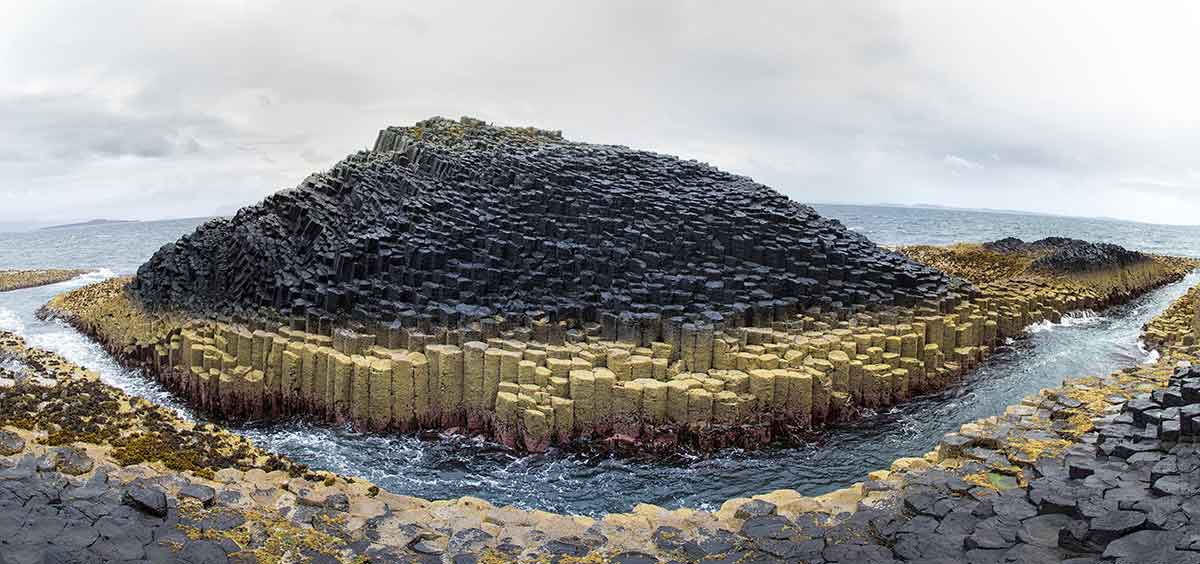
On the Isle of Staffa, the landscape is wild and windswept, and exceptionally beautiful.
It is however underneath the island where caves of otherworldly beauty are accessible only from the sea.
Fingal’s Cave is a sea cave of immense size.
The cave features unusual hexagonally shaped and joined basalt columns, making up a 227-foot cavern.
The floor of the cavern is sometimes hidden by the sea, however, when revealed a hexagonal walkway sits just above the surface of the water.
The cave is known as Uamh-Binn, or “The Cave of Melody”, and is believed, according to legend to be the opposite end of an ancient bridge linking Fingals Cave to Giants Causeway in Ireland.
13- Scottish Dark Sky Park
Situated at the edge of Galloway Forest Park, the Scottish Dark Sky Park sits underneath some of the darkest skies in the United Kingdom.
There are many dark sky parks across Scotland, however, the park at Galloway is one of only two ‘gold tier’ dark sky parks, and houses an observatory.
Dark sky parks are favoured by astronomers as they can get a far clearer view of the night sky as it is not spoilt by light pollution from cities.
The park is also home to spectacular landscapes, wildlife and culture, which are all protected under the Galloway and Southern Ayrshire UNESCO Biosphere.
14- Rannoch Moor
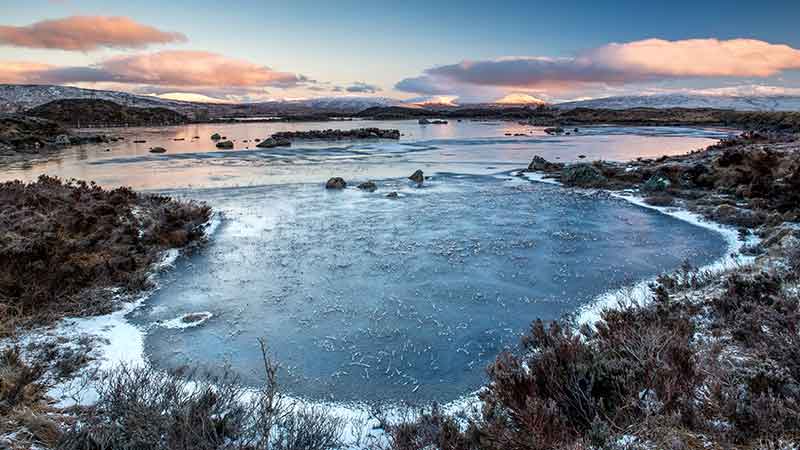
Rannoch Moor is a vast expanse of around 50 square miles of boggy marshland. The moor sits to the west of Loch Rannoch.
The moor is made up of blanket bog, lochans, rivers and rocky outcrops, adding to the barren and wild landscape.
Despite this challenging environment, Rannoch Moor supports a wide variety of flora and fauna. Animals in the area include curlews, grouse, roe and red deer.
Around the moor, there are many challenging walking and cycling routes taking visitors up into the remote hills.
The moor was regularly filmed on for the series Outlander.
15- The Old Man of Hoy
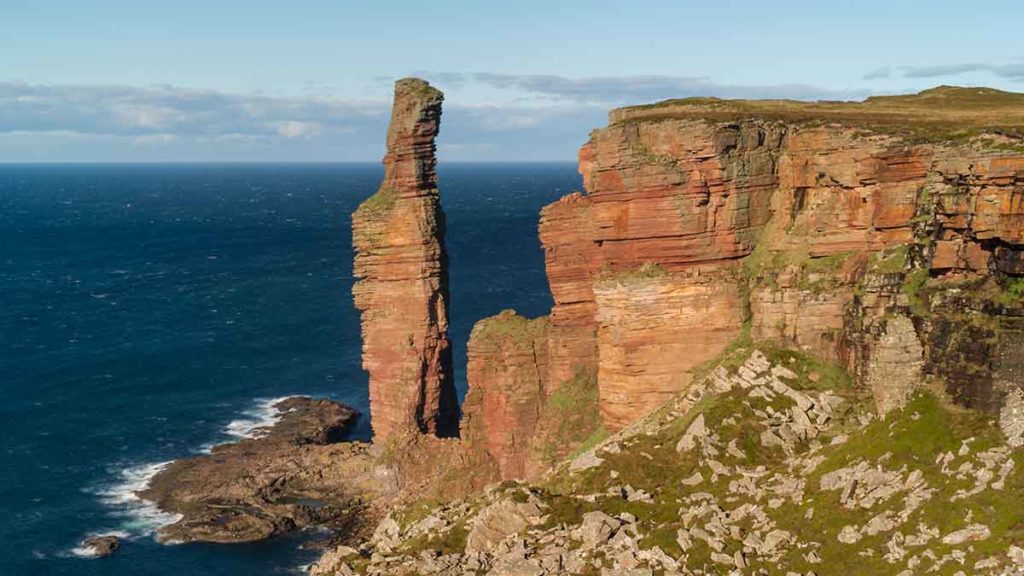
Standing proud in Rackwick Bay on the west coast of Hoy in Orkney is the Old Man of Hoy.
The rock itself is a stack of red sandstone perched on a basalt rock base and is one of the tallest sea stacks in the United Kingdom.
The Old Man of Hoy didn’t always exist and is only about 250 years old.
Sculpted by currents, wind and erosion, what was once an outcrop of land became an arch and eventually, the Old Man of Hoy separated from the mainland.
Due to the constant erosion, the Old Man of Hoy may soon collapse.
16- The Parallel Roads of Glen Roy
Marked on Ordinance Survey maps as roads, and once thought to have been built by the ancient Kings of Scotland or mythical Celtic hero Fingal, the Parallel Roads of Glen Hoy have been a source of mystery for centuries.
Despite published maps and legend, the roads are actually not roads at all.
The parallel lines seen along Glen Roy are in fact evidence of ice-dammed lakes that were once here, millions of years ago.
The National Park Reserve of Glen Roy has such diversity in its geographical features that it makes for an interesting stop on anyone’s trip to Scotland.
17- Corryvreckan Whirlpool
Corryvreckan Whirlpool sits within the Gulf of Corryvreckan, a narrow straight between the Scottish islands of Jura and Scarba, off the west coast of the mainland.
The straight is famed for its ferocious currents and tides, and at the right state of the tide, the third-largest whirlpool in the world, Corryvreckan, is formed.
Boat trips from the islands to the whirlpool are available and will take visitors across the gulf with other sights on offer including seal colonies, sea eagle nesting sites and in some instances dolphins, basking sharks and whales.
Some trips also take in the puffin colony on the Treshnish Isles.
Landmarks in Edinburgh
18- Edinburgh Castle
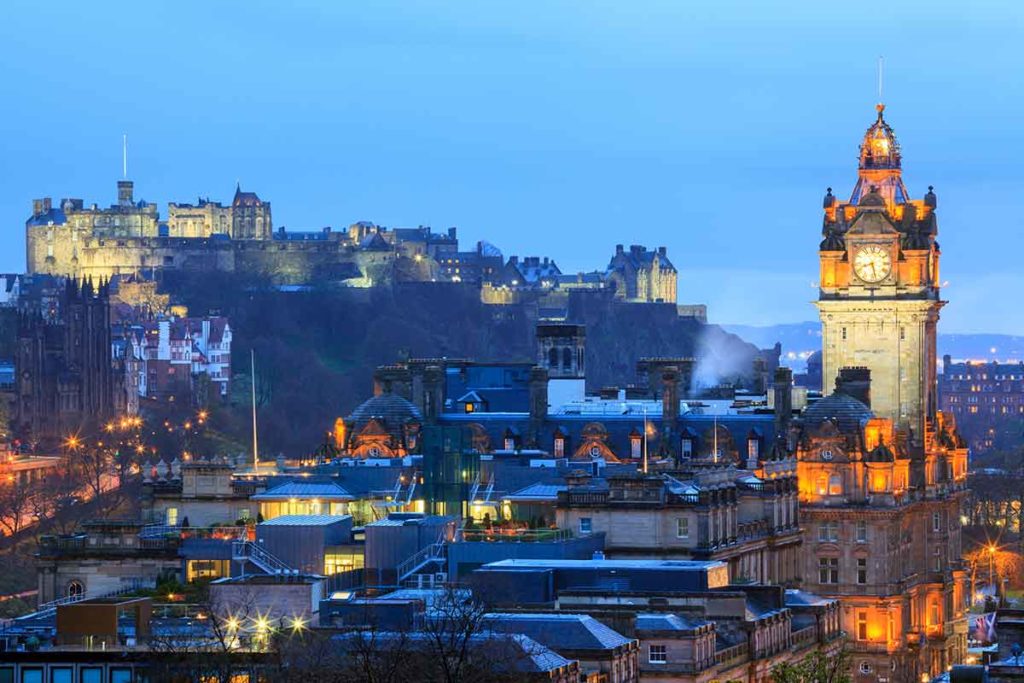
Overlooking Edinburgh, this iconic piece of Scottish history is part of Edinburgh’s Old and New Towns World Heritage Site.
The castle was once the home of Scottish monarchs and is now open to the public alongside its dedicated museum.
The castle sits at 443 feet above sea level and is perched on Castle Rock, a volcanic crag.
Having being formed from several early iterations, the oldest part of the castle is St Margaret’s Chapel, which dates back to the 12th century.
The famous Great Hall was completed in 1510 by James IV, with more additions coming to the castle in the 16th century.
Within the castle are housed the Honours (the crown jewels of Scotland), the Stone of Destiny and the One O’Clock Gun.
19- Scott Monument
Following the death of Sir Walter Scott in 1832, Edinburgh built a monument to him in recognition of his literary importance.
The design of the monument was based on a competition, where entrants could design a memorial they believed to be fitting.
The winning design was by George Meikle Kemp.
The resulting monument is the biggest monument to a writer in the world, standing at over 200 feet high.
The monument was designed in a Gothic architectural style and is made from Binny sandstone.
Within the monument is a spiral staircase taking visitors to the top of the tower for spectacular views over Edinburgh.
20- Greyfriars Bobby
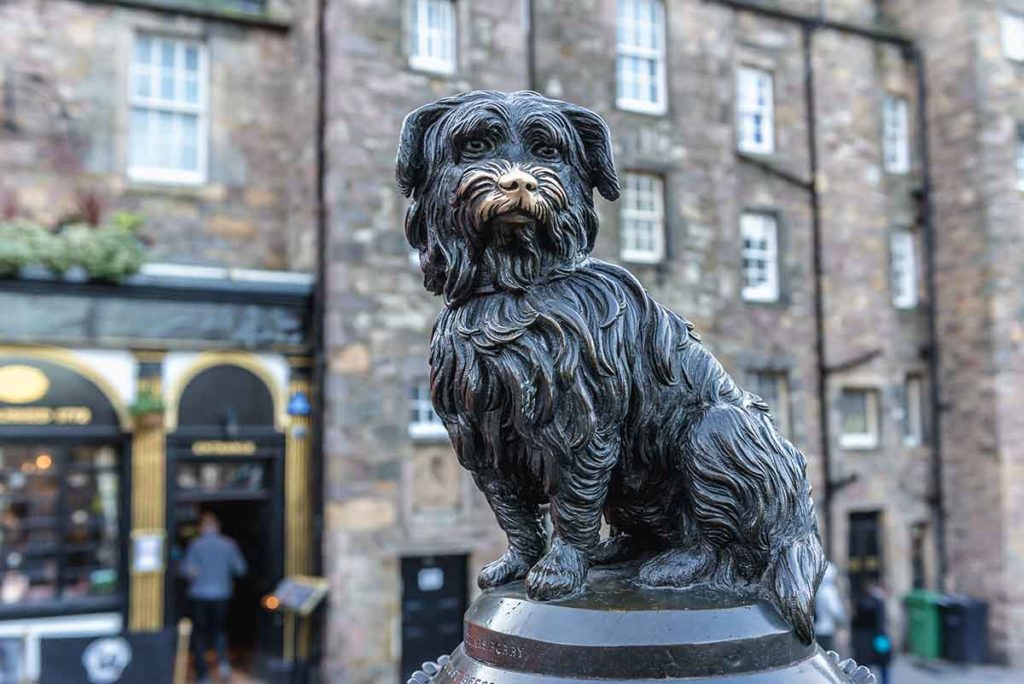
Perhaps one of the most famous dogs to have ever lived, Greyfriars Bobby is remembered by the city of Edinburgh through a statue sculpted from life by William Brody.
The statue was unveiled in 1873 and is marked with a fitting plaque dedicated to his loyalty.
Greyfriars Bobby belonged to a gardener named John Gray, who upon becoming a night watchman, began to work with his watchdog, Bobby.
Together they wandered the streets of Edinburgh and were firm friends.
When John died and was buried in Greyfriars Kirkyard, Bobby sat by his grave despite the weather, refusing to leave his side even in death.
The loyalty of this Skye Terrier to his old friend is celebrated through his statue.
- Best Time To Visit England
- 20 Hidden Gems in London
- 20 Famous Landmarks in London
- 20 Famous Landmarks in England
- 20 Famous Landmarks in Ireland
- 21 Famous Landmarks in Wales
- 20 Landmarks In Scotland
- 10 Beautiful Villages in the Cotswolds
- 21 Things To Do In York
- 20 Things To Do In Scarborough
- 20 Best Beaches In Scotland
- 20 Best Beaches In Wales
- 20 Day Trips From London
- 20 Ways To Spend Christmas In London
- 20 Things To Do In London At Night
- 20 Things To Do In Portsmouth
- 20 Things To Do In Exeter
- 20 Things To Do In Gibraltar
- 7 Beaches In Gibraltar
- 20 Things To Do In London In Summer
- 20 Things To Do In Autumn In London
- 20 Things To Do In Winter In London
- 20 Things To Do In Glasgow
- 10 Things To Do In Edinburgh
- 20 Things To Do In The Isle Of Skye
- 15 Things To Do In Derry
- 10 Things To Do In Belfast
- 5 Things to Do In Northern Ireland
- 5 Places To Go Whiskey Tasting In Dublin
- 20 Fairytale Castles In Scotland
- 20 Fairytale Castles In Ireland
- 20 Fairytale Castles In London
- Castles in Great Britain
- The Borough Markets
- Which London Museums Should I Visit?
- The Gore London Review
- 20 Things To Do In Leicester
- 20 Things To Do In Sheffield
- 20 Things To Do In Southampton
- 20 Things To Do In Blackpool
- 20 Things To Do In Ipswich
- 20 British Drinks
- 20 Things To Do In Bath
- 20 Things To Do In Cambridge
- 20 Things To Do In Newcastle
- 20 Things To Do In Leeds
- 20 Things To Do In Norwich
- 20 Things To Do In Brighton
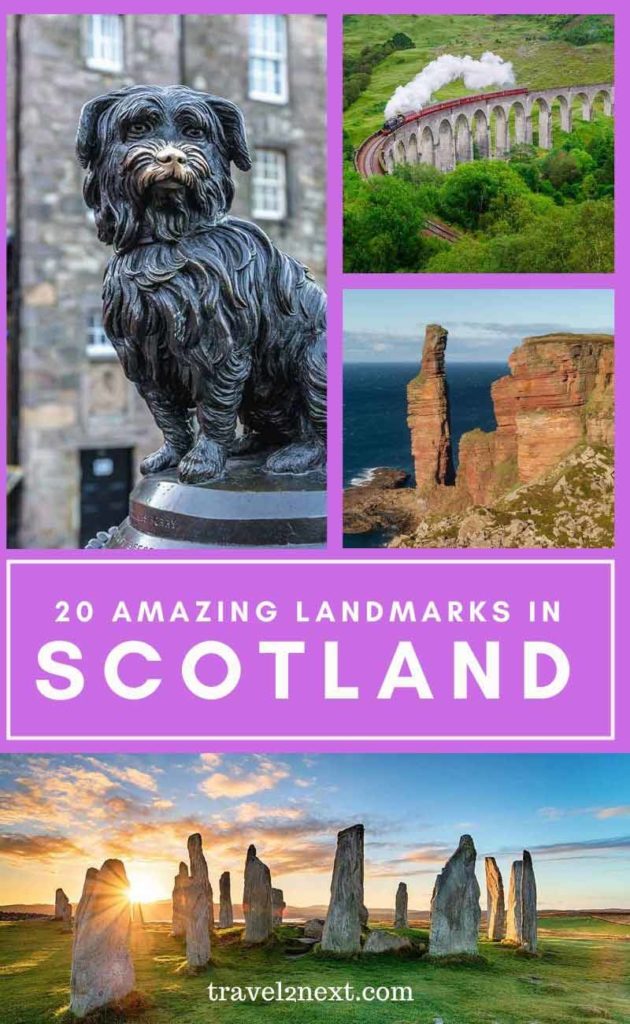
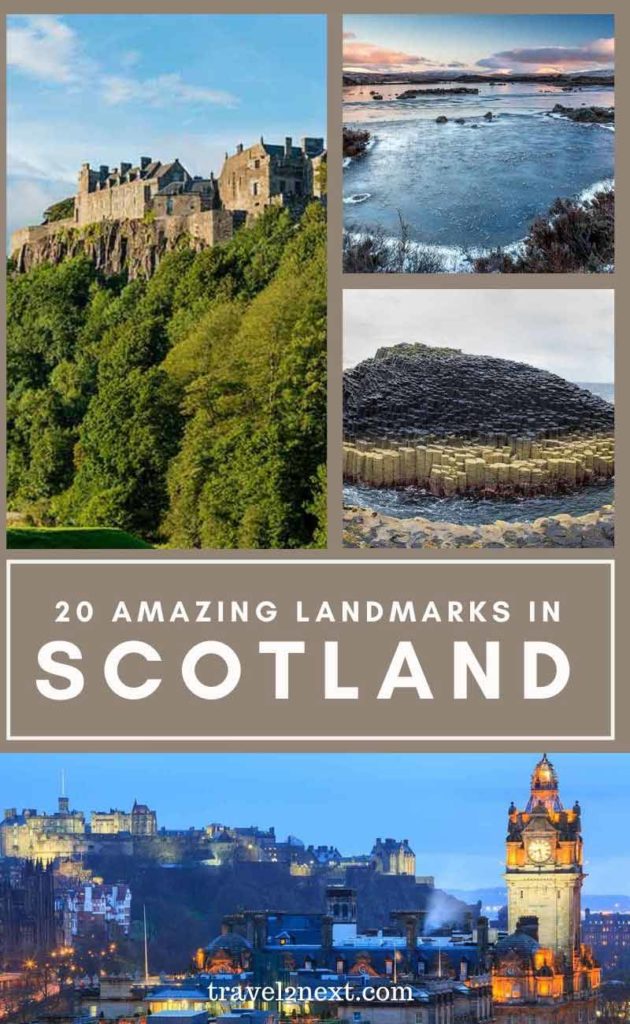
Plan Your Trip

Rent A Car – Find the best car rental rates at Discover Cars. They compare car hire companies to provide you with the best deal right now.

Find A Hotel – If you’re curious about this article and are looking for somewhere to stay, take a look at these amazing hotels.

